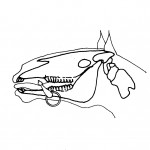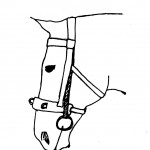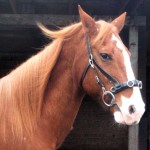-
The Bridle:
- We use a bridle (of correct size for our horse’s mouth), because it has a bit attached. When putting on the bridle you have learned that the corner of the horse’s mouth should show a little “smile”. This however is not enough proof that the bit is lying in the correct spot in the mouth!
- In the drawing you can see that part of the lower jaw, between the incisor teeth and the molars in the back, there is a space. In this space the bit rests – and should never, as in this drawing, touch any teeth!! That is, what you must check for, when adjusting a new bridle for your horse.
 The bit must NEVER touch any teeth !
- This part of the lower jaw is pure bone, just covered with a bit of skin. Nerves and blood vessels run in here and any pressure by the bit on this part hurts as much as if you, with bare shins, had to kneel on it. Keep this in mind!
- A little higher the bit rests on the tongue, a muscle full of nerve endings and blood vessels. By pulling on the bit the tongue gets depressed, often to the degree that the blood flow is impeded and the tongue turns bluish. Do me the favour to quickly bite your tongue and then keep that pain in mind too!
- The third place to cause your horse pain is the roof of the mouth: by exerting pressure on the bit in such a way that the bit “nut-crackers” to the top of the mouth you can really spoil your horse’s motivation for ever.
- A single jointed bit is more likely to nut-cracker and exerts more pressure on the jaw bone, while a double jointed bit compresses the tongue more.
- So now you understand that the bit of the bridle, when used by a hard human hand, is really a weapon – and until you can manage it gently and accurately you must avoid using it.
- How do you learn that? The best way is to teach the horse in other ways, by other means, how to behave at the end of the lunge line correctly: this must be the first phase of your training, before you progress to seeking the steady contact on the bit.
Cavesson :
- UNTIL the horse is able to keep steady contact on the lunge line with respect and manners (and that is not easy!) you MUST therefore use a cavesson or halter during training!
- The lunge line may not be attached to the bit of the bridle, but rather to the centre ring of the cavesson or to the halter – the same goes, in case of a nervous, fast horse also for the auxiliary reins (which we will discuss separately later). You already know that storming off is often a sign of fright – an attempt to flee, and it signifies that a sensible preparation with trust and respect training has been omitted.
- Even if the horse just lets off steam or gets rid of his bucks, the pressure on the ring of the bit would be 70 kilos of human weight via 10 meters of lunge line to 500 kilos of horse! Then the mouth becomes “hard”, so we say! It is however physically impossible for a horse’s mouth to become hard – let’s call things by their real name and say that it is the human hand, which is horribly rough – and it is the horse’s fate, which is hard, because he has to suffer all this.The weight of the lunge line alone, and the force needed to keep it in contact with the horse, are too much pressure on the horse’s tongue. The cavesson spares the horse’s mouth from pain and therefore makes a sensible and trustful cooperation with the lunging hand possible for the future.The cavesson has been used in all European riding academies since the 17th century. For lunging we use the Vienna type, which is the softest variety. This piece of equipment consists of a U-shaped metal bar, which is padded and rests on the nasal bone of the horse. It has rings added to it for attaching the lunge and reins. The cavesson influences the horse via pressure on the nose-bone. It must be fixed with a throat latch so it does not slide around, as otherwise it could hurt the horse’s eye. The nose bar should sit fairly high on the nose and above the cartilage of the nose, so it does not hurt or impede the horse’s breathing.
 We removed the nose band of the bridle. The nose band of the cavesson is passed under the straps of the bit.
- My cavesson is my only expensive piece of equipment and I use it a lot. I own one which allows me to also attach a bit via two side rings, which saves me doubling up the equipment. If you use bridle and cavesson together, then the bridle lies beneath it, but the nose band of the cavesson is threaded under the straps of the bit of the bridle. In this case I would remove the nose-band of the bridle altogether – and we don’t tie our horses’ mouths shut in any case.
- If you do not want to invest in a cavesson you can also use a simple halter in connection with the bridle: then the lunge line is affixed to the halter in order to spare the horse’s mouth. The disadvantage is only that the horse receives less clear impulses, as he does not feel the signals via his nasal bone.
 This cavesson has its own attachment for a bit
Next time we continue with the lunge line.
|
|
Die Trense:
- Wir benutzen eine Trense (passend für die Größe des Pferdemauls), weil daran ein Gebiß befestigt ist. Jeder hat gelernt, daß man beim Auftrensen darauf achten soll, daß das Pferdemaul ein kleines “Lächeln” zeigt. Das ist jedoch nicht Beweis genug, daß die Trense richtig paßt!
- In der Zeichnung kann man sehen, daß sich im Unterkiefer zwischen den Schneide- und den Backenzähnen ein zahnloser Teil, die Laden, befindet. Hier liegt das Gebiß – und sollte nie, wie hier in der Zeichnung, irgendwelche Zähne berühren!! Das ist, wonach man schauen muß, wenn man die Trense seinem Pferd anpaßt.
- Diese Laden sind blanker Knochen, mit Haut überzogen und voller Nerven und Blutgefäße. Jeglicher Druck des Gebisses auf die Laden tut dem Pferd genauso weh, wie wenn ich Sie zwänge mit dem blanken Schienbein darauf zu knien! Vergessen Sie das nicht!
- Weiter oben liegt das Gebiß auf der Zunge, ein Muskel voller Nerven und stark durchblutet. Beim Ziehen am Gebiß wird die Zunge gequetscht, oft so stark, daß sie bläulich anläuft, weil die Durchblutung behindert wird. Beißen Sie sich bitte mal schnell auf die Zunge und merken sich diesen Schmerz ebenfalls!
- Die dritte Stelle, an der man seinem Pferd im Maul wirklich weh tun kann, ist der Gaumen: wenn man mit dem Gebiß solchen Druck ausübt, daß es einen “Nußknacker-Effekt” auf den Gaumen hat, dann kann das die Motivation Ihres Pferdes für immer auslöschen.
- Ein einfach gebrochenes Gebiß verursacht eher den “Nußknacker-Effekt” und Druck auf die Laden, während ein doppelt gebrochenes mehr die Zunge quetscht.
- Nun verstehen wir also, daß das Gebiß in einer harten menschlichen Hand wirklich eine Waffe ist – und bis man es einfühlsam und akkurat einsetzen kann, muß man seine Anwendung vermeiden.
- Wie lernt man das aber? Am besten, indem man dem Pferd erst auf andere Weise beibringt, wie es sich am anderen Ende der Longe korrekt verhalten soll: dies muß die erste Phase Ihres Trainings sein, bevor man den leichten Kontakt am Gebiß sucht.
Kappzaum:
- BIS ein Pferd mit Anstand und Respekt den Kontakt an der Longe halten kann (und das ist nicht einfach) MUSS im Training ein Kappzaum verwendet werden! Die Longe darf nicht in der Trense eingehängt werden, sondern im Kappzaum (bei einem sehr stürmischen nervösen Pferd anfangs auch die Hilfszügel, die wir noch separat besprechen werden). Wie erwähnt ist solches Stürmen aber oft ein Zeichen von Angst – ein Fluchtversuch und bedeutet, daß die sinnvolle Vorbereitung mit Vertrauens- und Respektstraining übersprungen wurde!
- Auch bei einem bloßen Abreagieren des Stallmuts oder einem unwilligen Austoben würden beim Verschnallen der Longe im Trensenring 70 Kilo Menschengewicht über 10 Meter Longe an 500 Kilo oder mehr Pferdegewicht im Pferdemaul hängen! Dann wird das Maul “hart” , ja, so sagt man!! Es ist physisch unmöglich für ein Pferdemaul hart zu werden – nennen wir die Dinge doch endlich mal beim richtigen Namen! Es ist die menschliche Hand, die furchtbar grob ist – es ist oft das Pferdeschicksal, welches hart ist, weil es das erdulden muß!
- Allein das Gewicht der Longe und die nötige Kraft, um sie anstehen zu lassen, sind zu viel Druck auf die Zunge des Pferdes. Der Kappzaum schont das Maul und macht eine spätere sinn- und vertrauensvolle Zusammenarbeit zwischen dem Pferdemaul und der Longenhand überhaupt erst möglich.
- Ein Kappzaum ist seit dem 17. Jahrhundert in allen Reitakademien in Europa in Gebrauch. Wir benutzen zum Longieren die Wiener Variante, die am wenigsten scharf ist. Dieser Kappzaum besteht aus einem U-förmigen Metallstück, welches, mehr oder weniger gepolstert, über dem Nasenbein des Pferdes liegt und auf dem Ringe zum Befestigen von Longe oder Zügeln angebracht sind. Der Kappzaum wirkt über Druck auf das Nasenbein des Pferdes ein. Er muß fest sitzen und wird mit einem Ganaschenriemen gegen Herum- rutschen gesichert, da er sonst das Pferd am Auge verletzen kann. Er soll ziemlich hoch verschnallt werden, um eine Einwirkung auf den Knorpel des Nasenbeins zu verhindern, damit dem Pferd nicht die Luft abgeschnürt wird.
- Mein Kappzaum ist mein einziges teueres Ausrüstungsstück und ich benutze ihn viel. Ich habe einen, an dem man an Seitringen ebenfalls ein Gebiß einhängen kann. Das hat den Vorteil weniger Leder am Kopf zu haben. Wenn Trense und Kappzaum gemeinsam benutzt werden, wird der Kappzaum über die Trense gelegt, aber der Kinnriemen wird unter dem Trensengebiß hindurch geführt. Damit er aus dem Weg ist entfernen wir den Nasen- riemen der Trense ganz, da wir unseren Pferden eh nicht die Mäuler zubinden.
- Wer sich keinen Kappzaum leisten kann oder will, kann auch ein einfaches Stallhalfter in Verbindung mit der Trense benutzen: hier wird dann die Longe in das Halfter eingehängt, um das Pferdemaul zu schonen. Der Nachteil ist bei der Ausbildung nur, daß das Pferd weniger klare Hinweise empfängt, da es kein Signal über das Nasenbein verspürt.
Nächstes Mal geht es weiter mit der Longe. |